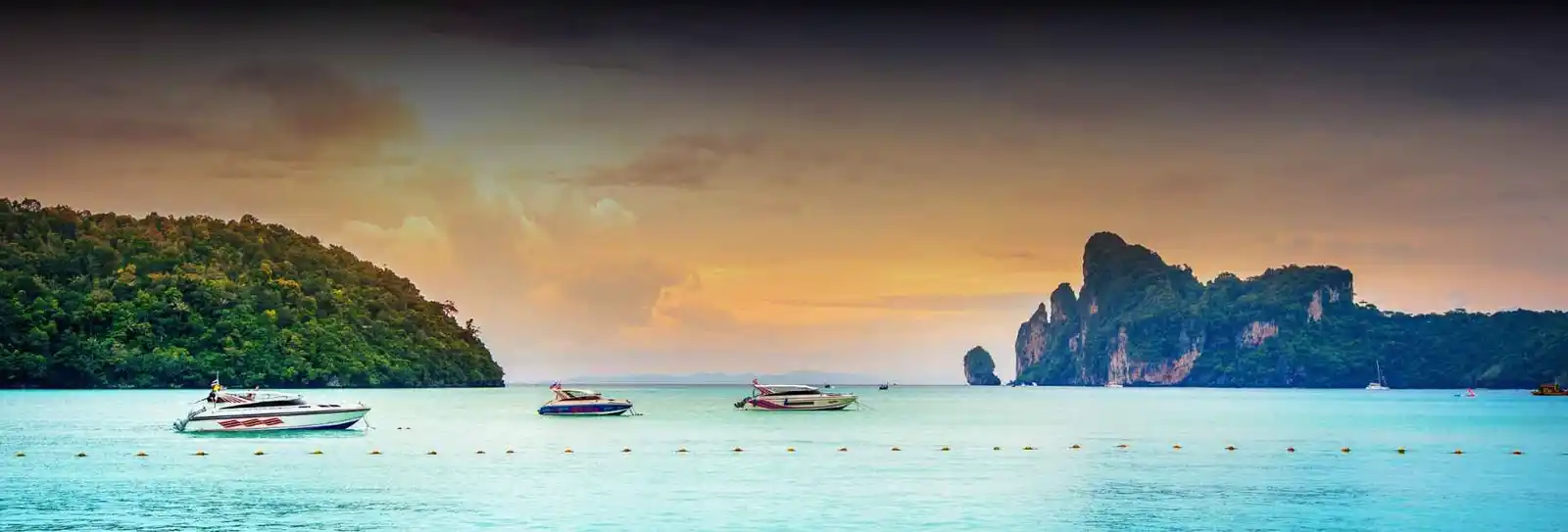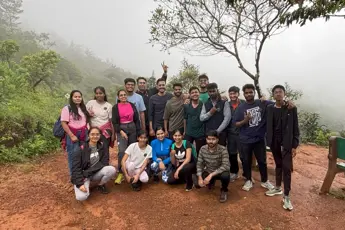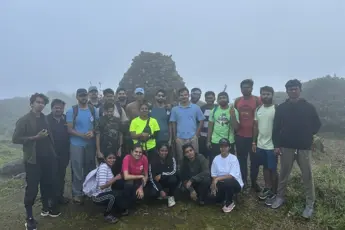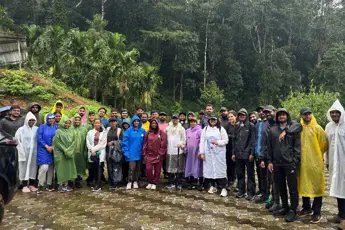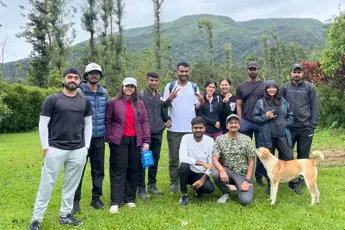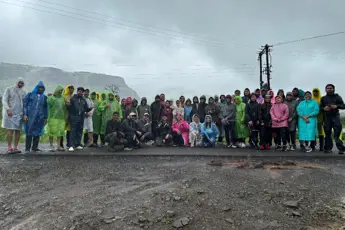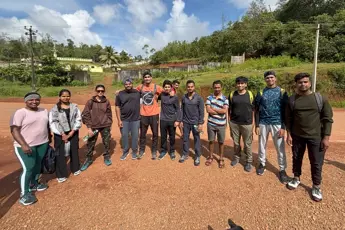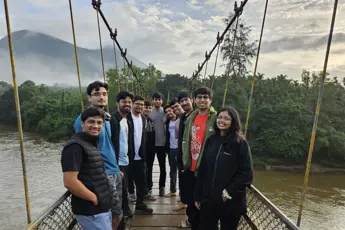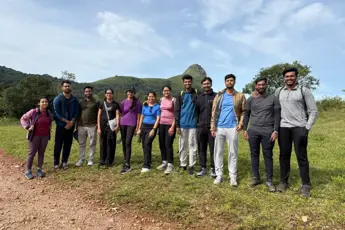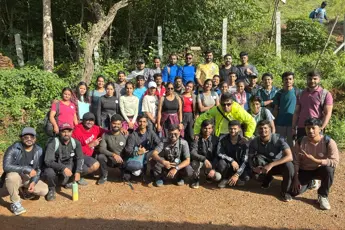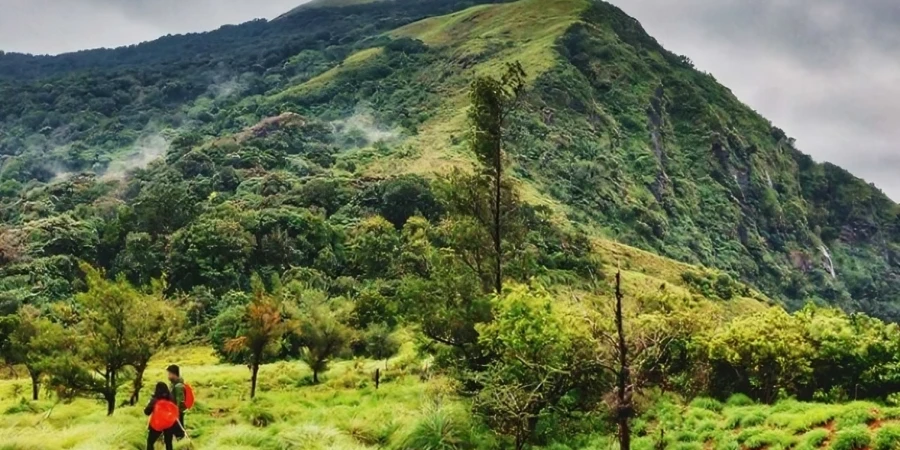
Hidden in Karnataka's Western Ghats amidst lush green surroundings, it is an off-the-beaten-path trekking spot in the Coorg (Kodagu) district. Famous for its surreal landscape, panoramic views, and peaceful atmosphere, it is one of South India's offbeat yet highly rewarding treks. Unlike its more famous counterparts, such as Tadiandamol or Mandalpatti, it provides a virgin nature experience, which is a must for nature enthusiasts and adventure seekers. At a height of about 4,100 feet (1250 meters) above sea level, this peak belongs to the Brahmagiri Range of the Western Ghats, a World Heritage site known for its astounding biodiversity and ecological value. It is accessible on a trail that goes through thick forests, rolling grasslands, coffee plantations, and clumps of shola forests, offering trekking enthusiasts the perfect blend of nature and adventure.The special thing about this Nishani Motte trek is that it is an off-the-beaten-path trek, and the trek attracts those who like a less frequented and private experience of trekking. Unlike overtly commercialised trails, it is not even claimed to be over-exploited, so perfect for trekkers who like to trek in small groups or individually. The trek itself is moderately demanding, about 13 to 15 kilometres long, and most appropriate for inexperienced trekkers. Besides the expedition, it is extremely important in Coorg's natural and cultural geography as well.Less Crowded and PristineMore off the beaten path compared to other very touristy trekking areas in Coorg, it is a serene location. The Nishani Motte trek itself is serene, with trekkers having the opportunity to get closely involved with nature without the inconvenience of large groups of people. It is therefore an ideal vacation spot for nature lovers as well as those who enjoy solitude.One of the Western Ghats' precious gems, is a picturesque trekking location in Karnataka's Kodagu district. Renowned for its ridges with a bird's-eye view from the top, forests, and serene woods, this trek is a vintage one to be left behind by no adventure seeker. Situated in the range of Brahmagiri, the trek is an amalgamation of wildlife exploration, steep ascents, and beautiful vistas. Below is a full guide that will help you plan your trek to Nishani Motte.Starting Point & Trail InformationThe trek to Nishani Motte formally begins from the source point, Tala Cauvery, a pilgrimage site and source point for the River Cauvery. TalaCauvery is used by trekkers as a base camp, and the path traverses the heavy Brahmagiri Wildlife Sanctuary in a full dose of natural atmosphere. The trek begins in a gradual ascent through the jungle and steeply upwards, later to ascend to the crest. The trekking route leads one through coffee plantations, rolling hills, and dense shola forests. The trek will have a combination of open grassland and densely wooded tracts, thereby making the trek interesting and eye-catching. The final segment is a ridge walk with breathtaking 360-degree views of the surrounding hills and valleys.👉 Looking for a thrilling monsoon trek near Bangalore? Don’t miss the chance to experience the Nishani Motte trek with Escape2Explore. This guided adventure offers scenic trails, an ancient fort, and breathtaking sunrise views — perfect for weekend getaways and nature lovers.Alternate RoutesWhile the most popular trail is the TalaCauvery trek, there is another trek from the nearby temple town of Bhagamandala. The trail is less populated and ideal for those seeking a non-touristy trek. However, this trail may require special permission from the forest department since it passes through protected areas. Less populated is the trail that comes from Cherangala, a small village in Coorg, and joins the main trail close to the sanctuary. That one gives trekkers a preview of isolated village life before the climbing begins.Difficulty Level & Distance: Trek is moderately challenging and best suited for beginners with sound physical fitness and experienced trekkers seeking an adrenaline-filled weekend getaway.Distance: The total trekking distance is approximately 12-14 kilometres (round trip). Estimated Trekking Time: Approximately 5-6 hours will be needed to complete the trek (inclusive of breaks and time spent in exploration).Altitude Gain and Difficulty RatingStarting Altitude: Around 1,276 meters (4,186 feet) at TalaCauveryMaximum Altitude: 1,360 meters (4,460 feet)Altitude Difference: Around 84 meters (275 feet)Though the altitude difference is minimal, steep slopes and rock-covered ground need energy and swift movements. Monsoon months (June–September) make the trek very tough with slippery trails and frequent leech attacks.Best Time to Trek: A Seasonal GuideTrekking, being a sport of adventure sport, gives the hobbyist an experience of witnessing the beauty of nature in its best form. However, the optimal time for a trek would differ based on numerous factors, from season to difficulty level and experience one wants to gain, i.e., photography, wildlife trail, or sheer adventure. In India, trekking is heavily dependent on the season. From green forests during the monsoon, to snow-capped mountains in winter, to green open meadows in summer, every season is beautiful in its own right.Seasonal Changes in Terrain and Difficulty LevelEach season provides a diverse landscape and contributes to variations in the level of intensity of treks. These variations are for the trekkers so that they would be able to select the most suitable time in terms of physical stamina, previous experience, and preferred landscape.Best Months-Picture March to June: Picturesque flowers, green fields, and blue skies make landscape photography an ideal treat. July to September: The greenery, misty valleys, and waterfalls give rise to dramatic landscapes. October to November: The pleasant weather and crystal-clear visibility of the mountains provide excellent photographs. December to February: The snowy trails and frozen lakes provide an ethereal landscape and an incredible opportunity for winter photography.Best Months for Wild Animals March to May: Most of the Himalayan wildlife species like snow leopards out at this time. After winter hibernation, the Western Ghats animals also emerge. October to November: The post-monsoon months are the period when migratory birds begin showing up in good numbers to offer excellent bird-watching opportunities.December to February: Most of the animals drop down to a lower altitude in search of food, hence easy to see.Best Months for Adventure Lovers Summer (March to June): Great for high-altitude treks and expeditions. Winter (December to February): Great for difficult treks on snow paths. Monsoon (July to September): Preferable for adventurous travellers who dare to tread through tough trails in bad weather.How to Reach Nishani Motte: A Travel GuideIt is a stunning but offbeat trekking spot in the Western Ghats in the Kodagu (Coorg) district of Karnataka. This off-beat trek is a fantastic experience through green canopies, rolling hills, and vistas, perfect for a weekend getaway for avid adventure seekers and nature lovers. For those adventurous few, I have a full guide describing the travel itinerary to Nishani Motte with information on the nearby airports, railways, bus stations and road transport from major cities like Bangalore, Mysore, and Mangalore.Nearest Airports to Nishani MotteMangalore International Airport (IXE) – Mangalore Airport (nearest to the hill, 150 km away) has a good connection to other cities in India, like Bangalore, Mumbai, Delhi, and Chennai. A cab, bus, or drive to the hill from Mangalore may be available. Kannur International Airport (CNN) –Another convenient access for South Indian travellers, it is located about 120 km away in Kerala. The airport is well-linked by both domestic and international flights. Kempegowda International Airport, Bangalore (BLR) –The Bangalore International Airport is about 300 km away and one of the busiest in India, serving international and domestic travellers alike. International travellers can opt for various road transport modes, such as cabs or buses or even drive down to Coorg and then the hill.Nearest Railway StationMysore Junction (MYS): A little over 120 km away, Mysore Junction has many trains coming in from Bangalore, Chennai, and other towns in southern India. You can get a taxi or bus from Mysore to Madikeri, which is the largest town.Mangalore Central Railway Station (MAQ): Approximately 150 km from here, well connected to various cities in India, it is the best option. Taxis or buses may be hired from Mangalore to access Coorg.Hassan Railway Station (HAS): Hassan station is 130 km away from here and may be used as an alternative for tourists by train. The connectivity is not very good with Mangalore or Mysore.Nearest Road Route and Bus StopMadikeri, the district headquarters of Coorg, is the main access to the hill. It has a proper bus stop, where buses operate regularly from other main cities. Madikeri Bus Stand- It is the nearest bus stand, 40 km away from the hill. Regular buses from KSRTC and private transport run from Bangalore, Mysore, and Mangalore to Madikeri. Virajpet Bus Stand bus stand serves as a stop for tourists heading to the hill, approximately 30 km away from here. Bhagamandala Bus Stop is a small stop near Talacauvery. Bhagamandala is closer to the trekking location. Auto-rickshaws and taxi services are also available from here.Road Routes to Nishani MotteTourists can drive themselves or take a cab to drive to the hill from nearby cities. The drive offers scenic views of coffee plantations, dense forests, and the misty hills of Coorg.From Bangalore (Around 300 km)Route 1: Bangalore – Ramanagara – Mandya – Mysore – Hunsur – Kushalnagar – Madikeri – Nishani MotteRoute 2: Bangalore – Nelamangala – Kunigal – Hassan – Sakleshpur – Madikeri – Nishani MotteTravel Time: Around 6-7 hoursRoad Condition: Smooth roads and good-laid roads for a smooth ride. The road to the last couple of kilometres before trekking begins is rough and would require an SUV or vehicle with high-ground clearance.From Mysore (Approx. 120 km)Route: Mysore – Hunsur – Kushalnagar – Madikeri – Nishani Motte Travel Time: Approximately 3-4 hours Road Condition: The roads are good with scenic views along the way. From Mangalore (Approximately 150 km) Route: Mangalore – Puttur – Sullia – Madikeri – Nishani Motte Travel Time: Approximately 4-5 hours Road Condition: The roads are good, although there are some sharp turns and steep ascents in some parts.Transportation OptionsOn cost and convenience, visitors can opt for the following:Buses – Private and KSRTC bus services operate a normal bus route from Bangalore, Mysore, and Mangalore to Madikeri. Local buses or cabs can be used to travel from Madikeri to the trekking spot.Cabs and Taxis – Taxis from Virajpet, Madikeri, and Bhagamandala are also available up to Nishani Motte. A cab can be booked through services like Ola, Uber (not widely available in Coorg), or with local travel agents.Self-Drive – Driving or biking is a great option for adventure lovers. The road to Coorg is picturesque and well-laid, and driving is a pleasurable experience. However, the final leg before beginning the trek might involve an off-road journey.Trek Essentials & PrecautionsClothing: Wear soaked clothing of moisture-wicking fabric and carry a raincoat as an alternative for the possibility of a monsoon trek.Trekking Shoes: Carry a good trekking shoe with proper gripping for bumpy treks.Food and Water: Carry energy bars, dry fruits, and nuts and sufficient water as there are no shops along the way.Leach Protection: Carry salt or Dettol spray for protection against leeches while performing the monsoon trek.Permits & Guide: A forest department permit is mandatory; it is also recommended to hire a local guide for safety purposes.Respect Nature: Do not litter and take care of the wildlife and nature around you.Basic Trekking Equipment & PlanningTrekking is a sport where nature gets to be the one taking charge of the adventure, their experience, and stunning scenery. But to construct a successful trekking tour, preparation and the right equipment must be employed. From kits to bring along to the exercise regimen and the procurement of required permits, the following list is comprehensive of what is needed for trekking and preparation.Packing checklistAn efficient packing list reminds the trekkers what to do and wear without extra weight. The list below is equipment, which is detailed later on:Apparel: Apparel should be selected according to climate, terrain, and length of trek. A layer system is recommended while adjusting to the climate.Base Layer: Insulating thermal, sweat-wicking (top and bottom), such that the sweat does not reach the skin.Mid Layer: Insulating fleece or down jacket for added warmth.Outer Layer: Waterproof outer layer jackets and pants, and Windstopper outer layer for rainy and windy weather.Trekking Pants: Light, air-permeable, moisture-wicking pants for easy movement.Trekking Shirts: Venting full-sleeved, moisture-wicking shirts for sun and bug protection.Gloves: Insulating gloves for freezing weather and lightweight gloves for ordinary weather.Socks: Blisters-reducing synthetic socks and cold-weather wool socks.Headgear: Sun hat or cap, beanie for cold, and balaclava or scarf for added protection.FootwearTrekking Boots: Waterproof, high-ankle, stable boots with good grip. Sandals/Flip-Flops: River crossing and campus walk.Gaiters: Keep the shoes and legs snowy, clean, and trash-free.BackpackMain Backpack: Multi-day backpack with well-padded 40- 60l system.Daypack: 10-20L daypack for daily hikes and to carry essential items such as water, snacks, and rain jackets.Rain Cover: Rain cover for the backpack.Camping EquipmentTent: Weather-resistant, light, and simple to set up.Sleeping Bag: Insulated according to the predicted temperature.Sleeping Pad: For ground insulation.Camping Stove & Fuel: Lightweight and compact stoves for cooking.Utensils & Cookware: Collapsible lightweight equipment such as a multi-tool knife, spork, and mess tin.Headlamp/Flashlight: For night visibility, with spare batteries.Food & WaterThere is always an ensured level of energy required to maintain the system watered and fueled with nutrients. Dry Fruits & Nuts: Energy-rich foods. Energy Chocolates & Energy Bars: Emergency protein and carb sources. Dehydrated Meals: Light meals for extended walking. Water Hydration System & Water Bottles: Keep a minimum of 2 litres of water and have hydration bladders for convenience. Water Purification Tablets/Filter: For filtration of natural water sources.First-Aid KitFirst-aid kits adequately supplied with medicines can be saviours in case of emergencies.Basic Medicines: Painkillers, anti-diarrhoea drugs, and altitude sickness pills.Bandages & Antiseptic Wipes: For dressing wounds and blisters.Thermal Blanket: To stay warm in emergencies.Personal Medications: Any medications prescribed.Navigation & CommunicationMap & Compass: B Battery-free old navigational tools.GPS Device: Useful for exact location tracking.Whistle & Signal Mirror: Useful in an emergency, useful to signal for help.Power Bank & Solar Charger: Useful to charge electronic devices.MiscellaneousTrekking Multi-Tool/Swiss Knife: Useful for miscellaneous tasks.Trekking Poles: Assist in avoiding knee pain and support to maintain oneself upright.Sunscreen & Lip Balm: Convenient to apply for protection from sunburn.Insect Repellent: Convenient to apply in regions where mosquitoes and bugs are common.Garbage Bags: Convenient for the proper disposal of trash.National Park PermitsA few of the treks go through national parks, and there are entry permits. A few of them are:Himalayan Treks: Inner Line Permit (ILP) and Protected Area Permit (PAP) are necessary for India's protected areas.Western Ghats Treks: Some trekking routes have forest department permits.Trekking Agency PermissionsCertain treks are reserved through registered trekking agencies for protection and safety.Local PermissionsIf the treks are on tribal or private property, local permissions are obtained and local culture must be maintained.Special PermissionsPermission for photography could be required in sensitive regions.Permission from the local authority might be required to fly drones.Other Treks in CoorgCoorg is a paradise for trekking enthusiasts, offering multiple trails that cater to different levels of difficulty and scenery preferences.Tadiandamol Peak: Tadiandamol Peak is Coorg's highest peak and one of Karnataka's most popular trekking places. At a height of 1,748 meters, the trek is renowned for panoramic views of the Western Ghats, dense forests, and grasslands. The climb to the summit has easy and moderately rough patches, and it is perfect for new and experienced trekkers. Trekking through the beautiful Shola forests and meadows, you are in for panoramic views of the unspoiled beauty of Coorg. The best time to visit Tadiandamol is post-monsoon, when the forests are green.Brahmagiri Hills: The Brahmagiri Hills trek is another visual treat of Coorg, offering a dreamlike combination of dense forests, rolling hills, and landscape. The trek goes up to the Brahmagiri Peak at an altitude of 1,608 meters. The trek starts along the Iruppu Falls and proceeds to the lush area of the Brahmagiri Wildlife Sanctuary. The summit provides a picturesque view of Kerala on one side and Coorg on the other. You can also spot other wildlife such as elephants, deer, and birds while in transit.Kumara Parvatha Trek: If trekking and wildlife discovery are what you are looking for, Pushpagiri Wildlife Sanctuary is where you should head. The sanctuary also identifies the location of the second-highest peak of Coorg, Pushpagiri (Kumara Parvatha), 1,712 meters above sea level. It is one of the toughest treks in Karnataka and a favourite among adventure enthusiasts who are willing to take on a tough but rewarding experience. Climbing upwards, you'll walk through dense forests, grasslands, and steep ridges to finally arrive at the summit with breathtaking views. Apart from trekking, tourists can also learn about the diversity of biodiversity in the sanctuary, such as endemic plants and threatened bird species.Waterfalls & Natural BeautyCoorg is replete with many waterfalls that contribute to the diversity of its rolling green landscape. The waterfalls are perfect places to relax, capture memories, and indulge in adventure in nature's calmness.Abbey Falls: Abbey Falls is one of the famous waterfalls in Coorg and is located only kilometres away from Madikeri. The fall jumps about 70 feet deep, with thick coffee plantations and spice estates surrounding it. The short trek to the falls is scenic, pampering with greenery. It's in the scope of monsoon and post-monsoon, at which time this makes the waterfall most prismatic and shows a really beautiful view and ambience of peace.Iruppu Falls: On the right Parenthesis, another of those lovely and stunning waterfalls of Coorg-Iruppu Falls, is near Brahmagiri Wildlife Sanctuary. It initially takes a fall of somewhere close to a height of 170 feet, from the Lakshmana Tirtha River, in different steps. Though Iruppu Falls is also an ancient sacred visiting spot as it is enshrined in the Ramayana mythology. People visiting the area may plunge into the cool waters of the river or enjoy the beautiful scenery of the place.Cultural and Historical AttractionsNot limited to beautiful sights and adventure pursuits, Coorg has a riveting past and rich cultural heritage tied to it. These places would lead one to appreciate more what was there in the past and the beliefs of this region.Madikeri Fort: This is a historical structure in Madikeri Fort signifying the mystique past of this place called Coorg. The structure of this fort was originally built by Mudduraja in the 17th century and later renovated by Tipu Sultan. It is indeed a magnificent piece of architecture: within the premises of the fort, visitors would be able to visit an ancient church, a museum that highlights some artefacts of history around Coorg, and also great stone structures. Being on a slight elevation makes it a beautiful place to visit by giving an eye-catching view of the town of Madikeri and the hills around it.Raja's Seat: A popular viewpoint in Madikeri-Raja's Seat. The view from here is stunning from sunrise until sunset over the hills and valleys; it has served as a holiday retreat to the kings of Coorg. The garden is lovely and well-kept, with seasonal flowers and musical fountains, which add to the beauty of the place. It's a great place to sit and watch the scenic landscape Coorg has to offer.Namdroling Monastery (Golden Temple): An unusual cultural attraction in Coorg-Bylakuppe is the Namdroling Monastery (Golden Temple). Located in this Tibetan Buddhist monastery are thousands of monks; this site is also a factor in being one of South Indiaþs biggest Tibetan settlements. Well known for the gilded statues of the Buddha, beautiful Tibetan architecture, and a peaceful atmosphere within itself, this place will allow visitors to watch the monks praying, and visit the vibrant murals and sculptures housed in the monastery.Why Book with escape2exploreWhen exploring the Nishani Motte trek from Bangalore and beyond, escape2explore stands out as a trusted name in adventure and experiential travel. Here’s why hundreds of travellers choose us for their getaways:Trusted, Well-Reviewed Local Operator: escape2explore has gained the trust of thousands of content tourists all over India. With persistent positive feedback and an unblemished reputation for delivering quality experiences, we assure your experience to be hassle-free, memorable, and value-packed. Our insider local knowledge guarantees that you to always be in safe hands.Seasoned Guides: Our trips are led by friendly, trained, and professional guides who are passionate about the outdoors and your safety. Whether it's a beach trek, a cultural tour, or a spiritual walk through temples, our team knows the terrain, the stories, and how to make each moment count.Safe & Curated Itineraries: Your safety is our number one priority. Each of our tour packages is thoughtfully crafted with safety measures, researched accommodations, and easy travel arrangements. We take care of the details so you can have the experience hassle-free and worry-free.Unique Experience That You Won't Find Anywhere Else: With escape2explore, you discover more than the tourist attractions. We go off the beaten track with hidden beaches, unusual treks, offbeat cultural destinations, and true interactions. Whether camping out beneath the stars or exploring a hidden beach cove, we present to you the other side of Nishani Motte that not many get to encounterRead: Bavikonda|Hampi|Kodaikanal|Wayanad|Tadianamol


